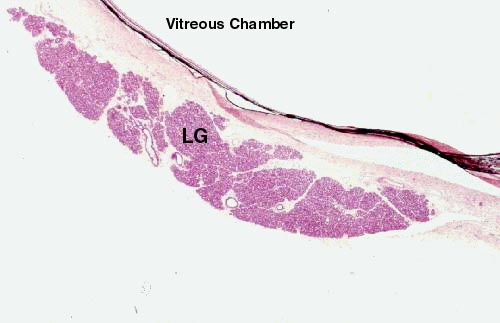Lachrymal Glands
 Tears are important. They're produced in special glands, and conducted to the surface of the eye by the glands' ductwork. The lachrymal glands are classified structurally as compound
tubuloacinar, and in terms of their secretion, they're serous. Their
secretion—tears—lubricates the surface of the eyeball and the
conjunctival pocket. There are lachrymal glands in several locations
around each eye, including one or two small ones in the eyelid.
Tears are important. They're produced in special glands, and conducted to the surface of the eye by the glands' ductwork. The lachrymal glands are classified structurally as compound
tubuloacinar, and in terms of their secretion, they're serous. Their
secretion—tears—lubricates the surface of the eyeball and the
conjunctival pocket. There are lachrymal glands in several locations
around each eye, including one or two small ones in the eyelid.
Tears are produced continuously, to keep the surface of the eye from drying out, and also to trap dust particles and other airborne material on a film of liquid. The "windshield wiper" action of the eyelids during a blink then can sweep the surface clean every few seconds. Tears also have an antibacterial action, one of their components being lysozyme.
Monkey lachrymal gland; H&E stain, paraffin section, 20x

Close This Window
 Tears are important. They're produced in special glands, and conducted to the surface of the eye by the glands' ductwork. The lachrymal glands are classified structurally as compound
tubuloacinar, and in terms of their secretion, they're serous. Their
secretion—tears—lubricates the surface of the eyeball and the
conjunctival pocket. There are lachrymal glands in several locations
around each eye, including one or two small ones in the eyelid.
Tears are important. They're produced in special glands, and conducted to the surface of the eye by the glands' ductwork. The lachrymal glands are classified structurally as compound
tubuloacinar, and in terms of their secretion, they're serous. Their
secretion—tears—lubricates the surface of the eyeball and the
conjunctival pocket. There are lachrymal glands in several locations
around each eye, including one or two small ones in the eyelid. 